Ever notice a strange bulge popping out of your tire sidewall? Don’t panic, but don’t ignore it either. A bubble in your tire sidewall can spell trouble if left unaddressed. You hop in your car expecting another smooth ride, then notice an odd protrusion sticking out from your tire as you head down the road. What is that strange bubble doing there and how did it get in your tire? More importantly, is it safe to keep driving like that?
Bubbles in Tires: Causes & What to Do
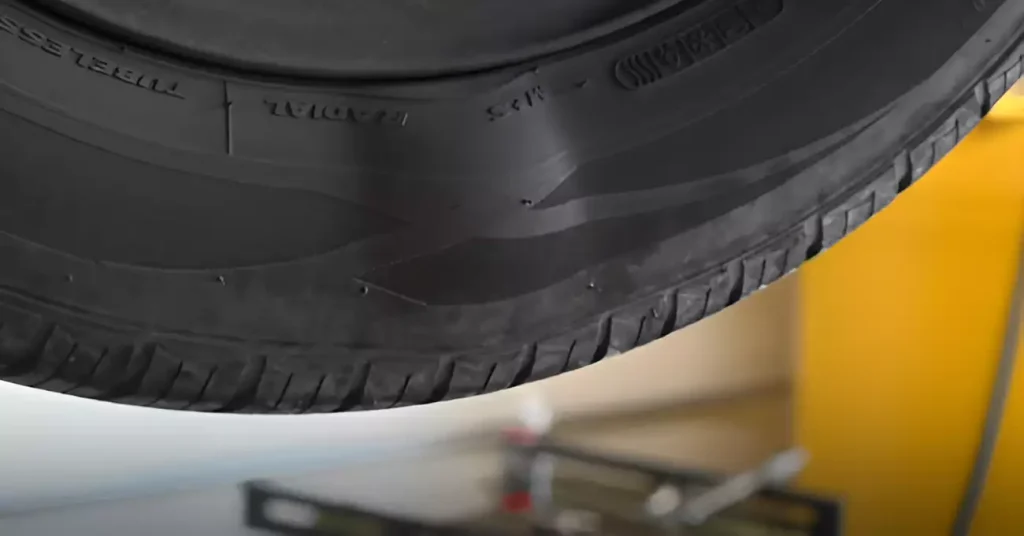
So you noticed a strange bubble forming on the sidewall of your tire. Don’t panic – it happens, and now it’s time to take action.
What causes those pesky bubbles?
Several things can cause bubbles to form in tire sidewalls:
- Damage from hitting curbs or potholes: Striking hard objects can weaken the sidewall, allowing air to escape.
- Weathering and aging: As tires get older, the rubber breaks down and becomes more porous.
- Improper inflation: Both overinflating and underinflating tires can stress the sidewalls and lead to bubbles.
- Manufacturer defect: Rarely, there may have been a flaw in the tire during production that now allows air to seep through.
Why you need to fix it fast
Driving on a damaged tire is dangerous, as the bubble can burst at any time, causing a blowout. A blowout leads to loss of control of the vehicle which puts you and others at risk. It’s simply not worth the gamble.
Solutions to get you back on the road safely
The only way to properly repair a bubble in the sidewall is to replace the tire. Options include:
- Buy a single new replacement tire. Replace just the damaged tire to save money. Make sure the new tire is the exact make, model, size, speed, and load rating as the others.
- Buy a pair of new tires. Replacing both tires on the same axle provides the best handling and braking. You’ll get the most life out of a matching pair.
- Buy a full new set of tires. For the best performance and safety, you can replace all four tires at once. This ensures even tread wear and handling.
A bubble in the sidewall is a sign that it’s time for a replacement. Don’t delay – get new tires installed and you’ll be driving with confidence again in no time. Your safety depends on it!
The Dangers of Driving With a Bubble in Your Tire
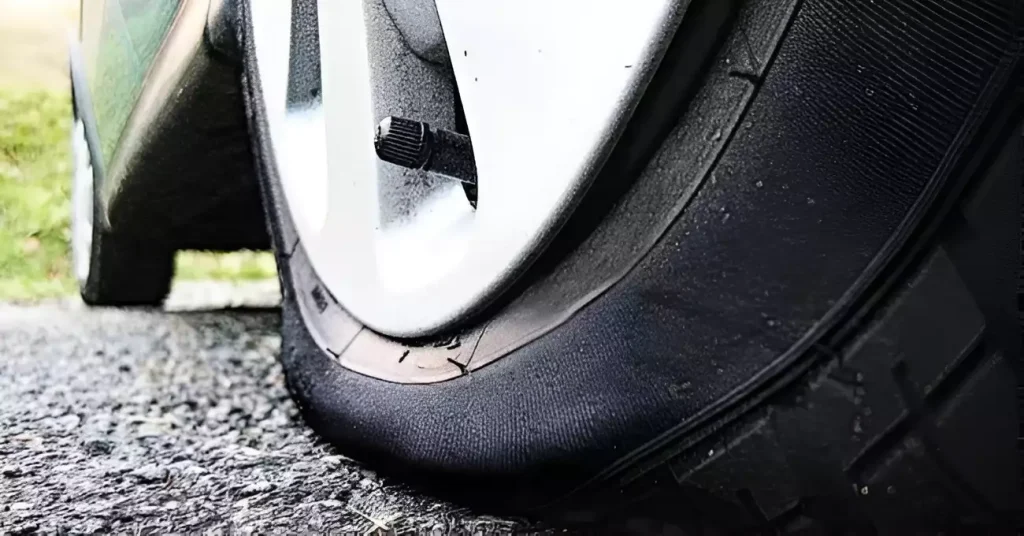
Driving with a bubble in your tire sidewall is dangerous and should be addressed immediately. Here’s why you need to get it checked out ASAP:
A bubble forms when the steel belts inside the tire start to separate and push outward. This weakens the structure of the tire, making it more prone to sudden failure or even blowout. At highway speeds, a blowout can lead to a loss of control of your vehicle, potentially causing a crash.
The bubble will continue to grow over time and with more miles driven. The bigger it gets, the greater the risk of catastrophic tire failure. It’s not worth risking your safety or the safety of your passengers to keep driving on a damaged tire.
In some cases, the bubble may be repairable, depending on its location and size. But more often than not, the tire will need to be replaced. It’s best to have the tire inspected by a professional as soon as you notice the bulge. They can determine if it’s safe to repair or if replacement is needed.
Waiting too long to address a bubble in your tire sidewall is extremely dangerous and irresponsible. Make the safe and smart choice by having your tire checked right away. Your life is worth the investment in a new tire or professional repair. Why put yourself or others at risk when the solution could be so simple? Be proactive about your vehicle’s safety and get that bubble checked today.
Should I Drive With a Bubble on My Sidewall?
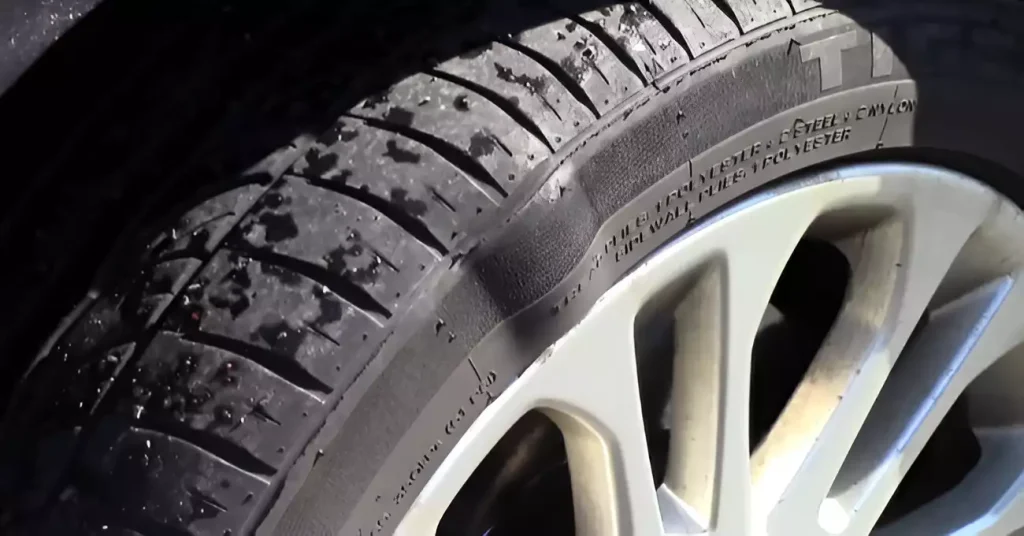
Should you drive with a bubble in your tire sidewall? In short, no. It’s not worth the risk. Sidewall damage can be dangerous if not addressed promptly.
Risk of Blowout
Driving on a damaged tire increases the chances of catastrophic failure, like a blowout. The sidewall provides structure and containment for the air pressure in your tire. A bubble forms when the cords underneath weaken or separate, unable to withstand the pressure. As you drive, these air pockets continue to expand until the tire ruptures. At high speeds, a blowout can lead to loss of control and a dangerous crash.
Risk of Damage Spreading
The bubble you see is only part of the underlying damage. Surrounding areas are also weakened and prone to failure. The damage may be spreading underneath with each revolution of the wheel, even as you drive cautiously to a repair shop. It’s not worth gambling with your safety or the safety of your passengers.
Solutions: Repair or Replace
The only way to fix a sidewall bubble and ensure safe driving is to:
- Repair the tire (if damage is minor)
- Replace the tire
Repairing a sidewall bubble involves applying an internal patch to reinforce damaged cords. If the bubble is small (less than 1⁄4 inch), repair may be an option. For larger damage, full replacement is best. When in doubt, replacement is the safest choice.
New tires provide peace of mind that you won’t end up stranded roadside with a shredded tire, or worse, lose control at high speed. Shop for a comparable replacement tire as soon as possible. Your life is worth the cost of a new tire.
In summary, sidewall bubbles require immediate action. Driving on a damaged tire is extremely dangerous and not worth the risk. Get your tire inspected right away and either repair or replace it so you can get back on the road safely. Your safety depends on the condition of your tires, so don’t delay!
How to Fix a Bubble in the Sidewall of Your Tire
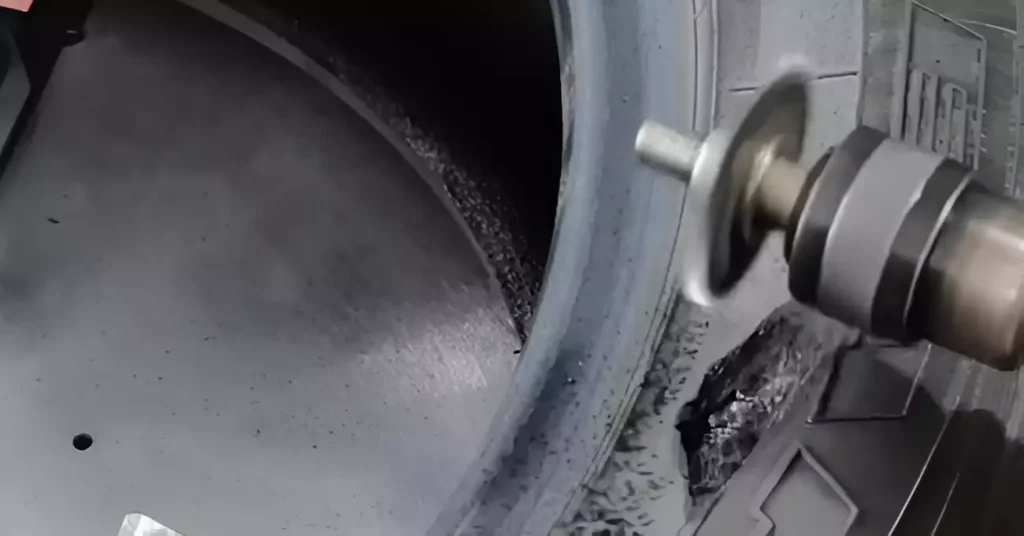
If you notice a bubble forming in the sidewall of your tire, don’t ignore it. This is a sign that the integrity of your tire has been compromised, and driving on it could be dangerous. Here are some steps you should take right away to fix the issue and ensure safe travel.
Inspect the Tire Closely
The first thing to do is inspect the bubble to determine the cause. Park the car on a level surface and turn off the engine. Closely examine the tire for any punctures, tears or damage in the sidewall. If there are visible cracks or cuts, this indicates the bubble was caused by impact damage and the tire should be replaced immediately. If the sidewall looks intact, the bubble could be caused by separation within the layers of the tire. Either way, the tire is unsafe to drive on and needs replacement.
Do Not Drive on the Tire
Driving even short distances on a damaged tire can be extremely dangerous. The bubble severely weakens the structure and stability of the tire, and it could burst at any time, causing a blowout. A blowout at high speeds may cause you to lose control of the vehicle. Do not drive the vehicle until the damaged tire has been replaced.
Replace the Tire Immediately
The only way to properly fix a bubble in the sidewall of a tire is to replace the tire. Sidewall damage cannot be repaired, and the bubble will continue to grow over time and with driving. Purchase a new tire that is the same size, speed rating, and load index as the other tires on your vehicle. Have the new tire mounted and balanced, and replace the damaged tire as soon as possible.
Consider Replacing Additional Tires
If the bubbled tire shows signs of aging or wear, it’s a good idea to consider replacing additional tires at the same time, especially if they are the same age or brand. As tires age, the rubber begins to break down and lose flexibility, increasing the chance of damage or failure. Replacing all four tires at once provides the best performance, handling, and safety.
How Much Does It Cost to Repair or Replace a Damaged Tire?
So you’ve noticed a strange bulge in the sidewall of your tire. Don’t panic—it’s usually repairable. Here are the most common causes of sidewall bubbles, the risks involved, and solutions to get you back on the road safely.
The main causes of sidewall damage are impacts and weathering. An impact from hitting a pothole or curb at high speed can weaken and damage the sidewall components, causing a bubble to form. Weathering and sun exposure over time can also weaken and dry out the rubber, leading to cracking and bulging.
Driving on damaged tires poses serious risks. The sidewall is responsible for supporting the weight of your vehicle. A bubble indicates structural damage that compromises this support. The tire is more prone to blowouts, flats, and losing pressure. This can lead to loss of control and accidents. It’s not worth the risk—get it checked out right away.
The solution depends on the severity of the damage. Minor sidewall damage may be repairable with a tire patch or plug for $20 to $60 per tire. More significant damage will require tire replacement. New tires typically range from $50 to $500 or more per tire depending on the brand, size, and type. It’s best to replace all four tires at once to ensure even wear and handling.
Some tire shops offer used or retreaded tires at a lower cost. However, for safety reasons, it’s best to avoid used tires if possible and stick with reputable new tires. Your life is worth the investment!
To avoid sidewall damage in the first place, maintain proper tire pressure, avoid potholes and curbs when possible, and limit exposure to environmental elements like sun and ozone when tires are not in use. Regular tire rotation and balancing will also help maximize the life of your tires.
Staying on top of your tire care and handling any damage promptly will give you peace of mind and keep you safely on the road for years to come. Drive safe!
How to Prevent Future Tire Bubbles
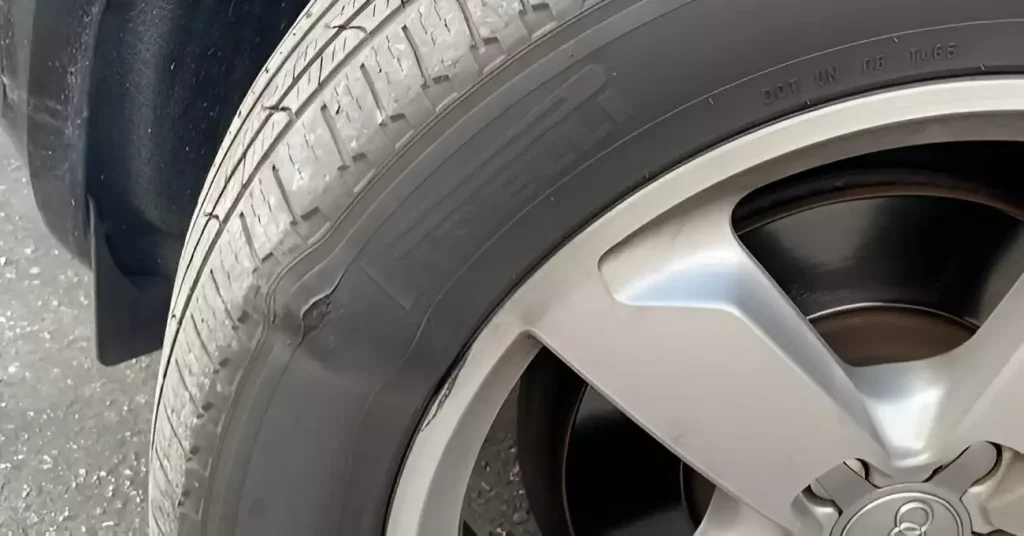
To prevent future tire bubbles, there are a few key things you can do.
#1. Inspect Tires Regularly
Check your tires at least once a month for any signs of damage or wear and tear. Look closely at the sidewalls for small cracks, punctures, or bulges. Catching problems early can help avoid dangerous tire failure down the road. If you notice any concerning damage, have the tire checked by a professional as soon as possible?
#2. Maintain Proper Tire Pressure
Under-inflated tires heat up more which can weaken the sidewalls over time and lead to bubbles. Use a quality tire pressure gauge to check your PSI at least once a month and inflate to the vehicle manufacturer’s recommended levels. Over-inflating tires can also cause damage, so don’t go above the max PSI listed on the sidewall.
#3. Avoid Potholes and Curb Impacts
Striking potholes, curbs, and other road hazards at high speeds can bruise or puncture your tire sidewalls which eventually results in bubbles. Drive cautiously, especially on rough roads, to avoid harsh impacts that could damage your tires. If you do hit something hard, have your tires checked to ensure there are no issues?
#4. Consider Tire Rotation
Rotating your tires means moving them to different positions on your axles, which helps them wear more evenly over time. This can extend the overall life of your tires and may help prevent premature sidewall damage or tread separation that leads to bubbles. Check your owner’s manual for the recommended rotation pattern and interval for your specific vehicle.
#5. Replace Old or Worn Out Tires
As tires age, the rubber compounds start to break down which makes the sidewalls more prone to damage and bubbling. Most tire manufacturers recommend replacing tires every 6 years, even if there’s still decent tread left. When in doubt, it’s best to replace older tires to ensure safety and performance. Your life is worth the investment!
Following these prevention tips will help keep your tires in good shape for the long haul. Staying on top of tire care and maintenance is the best way to avoid dangerous driving situations and enjoy many safe miles on the road.
FAQ: Can I Patch a Bubble in My Tire?
A bubble in your tire sidewall is never a good sign. While alarming, the good news is you may be able to fix it as a temporary solution to get you by for now. Here are the most common causes of sidewall bubbles and whether patching is recommended:
Impact Damage
If you’ve hit a pothole or curb recently, this could have damaged the sidewall and caused a bubble. The impact may have weakened the sidewall, allowing air to get trapped between the layers. Patching is not recommended in this case and you should replace the tire as soon as possible. Continuing to drive on an impact-damaged tire is dangerous.
Defect in Tire
Occasionally, manufacturing defects can lead to bubbles in the sidewall. If the bubble appears shortly after purchasing new tires, it’s best to have the tire checked by the manufacturer or dealer. They may replace the tire at no cost to you. Patching a defect is not a safe solution and the tire should be replaced.
Weather Cracking
Over time, exposure to sunlight and extreme weather conditions can cause the rubber in tires to weaken and crack. Bubbles form when air gets in through these cracks. While patching may hold temporarily, it’s best to start budgeting for new tires to ensure maximum safety and performance.
Improper Inflation
Driving for long periods with under-inflated or over-inflated tires leads to excess stress and heat buildup, damaging the sidewalls. Patching may work short-term but won’t address the underlying issue. Check your tire pressures frequently and inflate to the recommended levels listed in your owner’s manual or on the tire placard located in the driver’s side door jamb or fuel door.
As you can see, sidewall bubbles usually indicate significant damage or wear and patching is not a reliable long-term solution. For your safety, the best options are to replace the tire or at minimum have it inspected by a tire professional as soon as possible. Your life is worth the investment!
FAQ: Will My Tire Warranty Cover Bubble Damage?
Your tire warranty likely won’t cover damage caused by bubbles in the sidewall. Tire manufacturers typically only warranty defects in materials or workmanship for the first few years. Bubbles are usually caused by impacts, punctures, or excessive heat from driving—things outside the maker’s control.
- Impact damage: Hitting potholes, curbs, or debris at high speeds can damage the sidewall, causing air pockets to form. Unfortunately, this type of damage isn’t covered under warranty.
- Punctures: A small puncture in the sidewall allows air to escape and get trapped between the belts and casing. This stretches and weakens the sidewall, creating a bulge. Again, punctures fall outside the scope of tire warranties.
- Overheating: Aggressive driving, overloading a vehicle, or improper tire pressure can cause tires to overheat, breaking down the sidewall components. The resulting bubbles are considered wear and tear, not a defect.
Should I keep driving on bubbly tires?
Absolutely not. Bubble damage significantly weakens the sidewall, putting you at high risk of a blowout. Get those tires replaced as soon as possible for maximum safety. It’s not worth risking an accident to save a few bucks. Your life is far more valuable!
New tires may seem like an unnecessary expense, but consider it an investment in your safety and well-being. Shop around at different retailers to find the best deal on a high-quality, reputable brand of tires. Your local warehouse club, tire shop or mechanic should be able to find you an affordable replacement option to get you back on the road safely.
While bubble damage isn’t usually covered under warranty, some tire makers or retailers may offer prorated replacement credit or a discount on a new set of their tires as a courtesy. It never hurts to ask! The most important thing is getting those damaged tires off your vehicle. Your life depends on it!
FAQ: Is It Safe to Drive on a Repaired Tire With a Former Bubble?

If you notice a bubble forming in the sidewall of your tire, it’s important to address it right away. While driving on a repaired tire with a former bubble can be safe in some cases, it really depends on the cause and severity of the damage. Here are some things to consider:
The Cause Matters
Small punctures or damage from potholes are often repairable, but sidewall bubbles caused by impact damage, defects, or dry rot usually mean it’s time for a replacement. Have a mechanic thoroughly inspect the tire to determine the underlying cause of the bubble. If it’s minor damage, a repair may be an option. But for structural weaknesses or defects, driving on that tire is risky.
Consider the Risks
Driving on a damaged sidewall poses serious risks like blowouts, loss of control, or hydroplaning. The sidewall provides structure and support for the tire, so damage compromises safety. While a repair may seem convenient, your life is worth the cost of a new tire. It’s not worth the gamble.
Repairs Aren’t Always Reliable
Even if a mechanic is able to repair the bubble, the tire will never be as structurally sound as before. Repairs only provide a temporary solution and the damage may continue to spread. For the best safety, replace the tire as soon as possible.
New Tires Give Peace of Mind
Investing in a new tire to replace one with sidewall damage will give you confidence in your vehicle’s safety and performance. You’ll have the assurance of a fresh, undamaged tire for many miles to come. Your life and your passengers’ lives are worth the cost.
When it comes to bubbles in the sidewall, don’t take chances. Have the tire inspected and replaced if there are any signs of structural damage or weakness. While driving on a repaired tire may seem temporarily fine, your safety depends on tires that are undamaged and built to perform. New tires are the smartest option for your well-being and peace of mind.
Conclusion
So there you have it, everything you need to know about that bubble in your tire sidewall. Don’t ignore it – get it checked out as soon as possible. While the causes are often minor, the risks to your safety are real. The good news is most tire bubbles can be repaired if caught early, saving you money and avoiding unnecessary tire replacement. Knowledge is power, so now that you understand the problem, you can take action. Get a professional tire inspection right away. Your life is worth it, and so is the investment in safe, reliable transportation. Stay safe out there!

